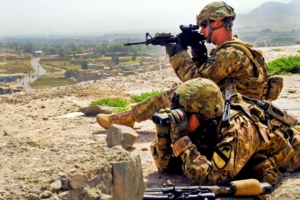Army Outlines Modernization Plans

By Debbie Gregory.
The Army is looking to the future to determine what will be necessary to support ground warfare in the years to come.
Training and Doctrine Command (TRADOC) has refined the previously revealed “Big 8” modernization priorities to the “Big 6+1” set of initiatives, with the “+1” referring to soldier and team performance and overmatch which cuts across all other capabilities listed.
The Army has carved out solid modernization objectives and identified the resources needed to meet capabilities in the near-, mid-, and far-term, prioritizing updates to its aviation fleet, combat vehicles, cross domain fires, robotics and autonomous systems, advanced protection, and cyber and electromagnetic capabilities.
Beginning next year and through 2022, the Army will complete its aviation restructure initiative and continue to modernize the AH-64 Echo-model, the UH-60 Mike- and Victor-model Black Hawk utility helicopters and the CH-47F Chinook cargo helicopter.
In in 2017 and 2018, the Army will test fly both a Bell Helicopter- and Lockheed Martin-developed tiltrotor helicopter and a Boeing and Sikorsky-made helicopter with coaxial rotor blades.
The Army will be taking a close look at combat vehicles, addressing shortfalls in mobility and lethality within the Infantry Brigade Combat Teams.
The service will also improve Stryker lethality for the 2nd Cavalry Regiment. Outfitting the vehicle with a 30mm cannon on 81 of the infantry carriers is being fast-tracked with plans to start fielding in 2018.
The Armored Multi-Purpose Vehicle (AMPV) will replace the obsolete M113 armored personnel carriers first fielded in 1960. BAE Systems presented its first general-purpose AMPV variant to the Army at its York, PA facility.
The Army will also focus on developing next-generation power trains that will provide a 50 percent increase in power and will also work on a durable light weight track with hopes of reducing weight and cost while not losing durability.
The Army will develop a Future Fighting Vehicle to replace the Bradley Fighting Vehicle.
From 2018 to 2022, the Army will work on increasing operations at safer standoff distances for the force through robots and autonomous systems. As part of that, the service will develop Automated Ground Resupply through leader-follower robotics technology. Robots will also have the capability to conduct route clearance and counter improvised explosive devices as well as improve situational awareness.
Military Connection salutes and proudly serves veterans and service members in the Army, Navy, Air Force, Marines, Coast Guard, Guard and Reserve, and their families.

















